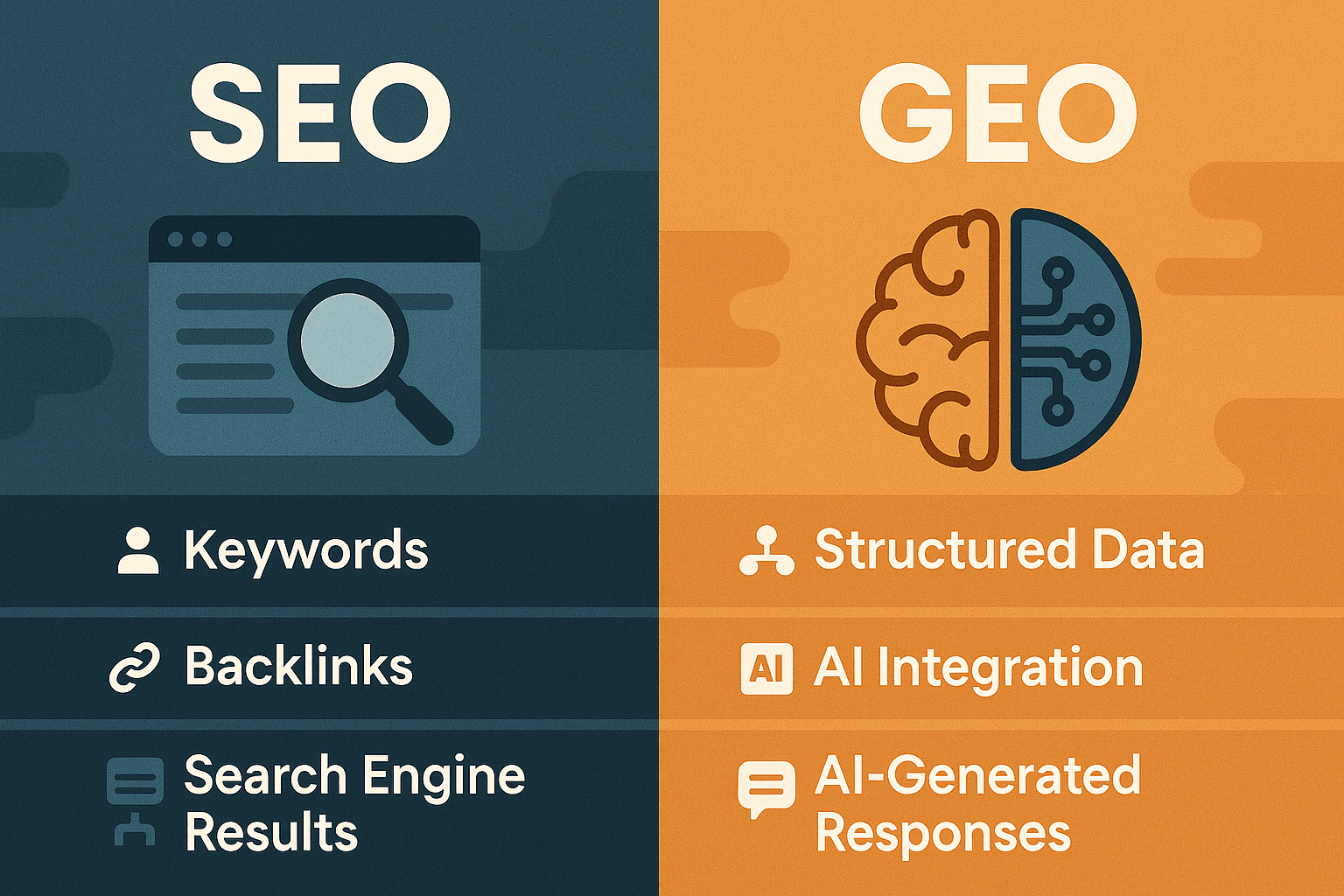1. Introduction to GEO and SEO
Table of Contents
In the rapidly evolving digital landscape, understanding the nuances between Generative Engine Optimization (GEO) and Search Engine Optimization (SEO) is crucial for businesses aiming to maintain visibility and relevance. While SEO has long been the cornerstone of online visibility, the emergence of AI-driven platforms has introduced GEO as a complementary strategy.
2. What Does GEO Stand For?
Generative Engine Optimization (GEO) refers to the practice of optimizing content specifically for AI-powered platforms like ChatGPT, Bing Copilot, and Google’s Search Generative Experience (SGE). Unlike traditional SEO, which focuses on keyword placement and backlinks, GEO emphasizes structured data, semantic clarity, and AI-friendly content formats.
3. GEO in Digital Marketing
In digital marketing, GEO plays a pivotal role by ensuring content is discoverable and relevant in AI-generated responses. As AI platforms become primary sources of information, optimizing content for these engines is essential. This involves:
- Structured Data: Implementing schema markup to help AI understand content context.
- Semantic Clarity: Writing content that is clear and easily interpretable by AI.
- AI-Friendly Formats: Utilizing formats that AI platforms can easily process and present.
4. GEO vs SEO: Key Differences
| Aspect | SEO | GEO |
|---|---|---|
| Focus | Traditional search engines | AI-driven platforms |
| Techniques | Keywords, backlinks | Structured data, semantic clarity |
| Content Format | Web pages, blogs | AI-friendly snippets, structured content |
| Goal | Improve SERP rankings | Enhance AI-generated responses |
5. How GEO Works
GEO involves optimizing content to be easily processed and presented by AI platforms. Key components include:
- Structured Data: Using schema markup to define content elements.
- Semantic Clarity: Ensuring content is straightforward and unambiguous.
- AI-Friendly Formats: Creating content that aligns with AI processing capabilities.
6. Optimizing for GEO
To effectively optimize for GEO:
- Implement Structured Data: Use schema.org markup to define content elements.
- Focus on Clarity: Write content that is concise and easily understood.
- Monitor AI Platforms: Stay updated on how AI platforms present information.
7. GEO Websites
Websites optimized for GEO:
- Utilize structured data extensively.
- Present content in formats conducive to AI processing.
- Focus on clarity and relevance.
Examples include:
- FAQ Pages: Providing clear answers to common questions.
- How-To Guides: Offering step-by-step instructions.
8. Is SEO Dead After AI?
While AI has transformed search behaviors, SEO remains relevant. However, integrating GEO strategies ensures content remains visible across both traditional and AI-driven platforms.
9. Best AI Search Engines
Leading AI search engines include:
- ChatGPT: Offers conversational responses.
- Bing Copilot: Integrates AI into search results.
- Google SGE: Provides AI-generated overviews.
- Perplexity: https://www.perplexity.ai/
Optimizing for these platforms involves understanding their content processing and presentation methods.
10. Future of Search Optimization
As AI continues to evolve, the integration of GEO and SEO strategies will become standard practice. Businesses must stay agile, adapting to new technologies and search behaviors to maintain visibility.
❓ FAQs
Q1: What is the primary difference between GEO and SEO?
A1: SEO focuses on optimizing content for traditional search engines, while GEO targets AI-driven platforms, emphasizing structured data and semantic clarity.
Q2: How can businesses implement GEO strategies?
A2: By incorporating structured data, ensuring content clarity, and staying informed about AI platform updates.
Q3: Is SEO still relevant in the age of AI?
A3: Yes, SEO remains crucial, but integrating GEO strategies enhances content visibility across AI platforms.
Q4: What are some tools for GEO optimization?
A4: Tools like schema.org for structured data and AI monitoring platforms help in GEO optimization.


Leave a Reply